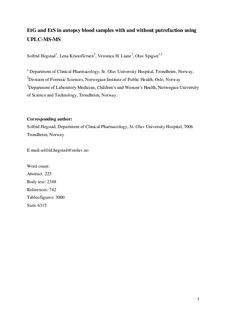| dc.contributor.author | Hegstad, Solfrid | |
| dc.contributor.author | Kristoffersen, Lena | |
| dc.contributor.author | Liane, Veronica Horpestad | |
| dc.contributor.author | Spigset, Olav | |
| dc.date.accessioned | 2018-01-26T09:51:17Z | |
| dc.date.available | 2018-01-26T09:51:17Z | |
| dc.date.created | 2016-12-27T10:37:05Z | |
| dc.date.issued | 2017 | |
| dc.identifier.citation | Journal of Analytical Toxicology. 2017, 41 (2), 107-113. | nb_NO |
| dc.identifier.issn | 0146-4760 | |
| dc.identifier.uri | http://hdl.handle.net/11250/2479800 | |
| dc.description.abstract | Analytical challenges related to postmortem specimens are well known. The degree of putrefaction of the corpse will influence the quality of the blood samples, and both the efficiency of sample preparation and the subsequent chromatographic performance can be affected. An ultra performance liquid chromatography-tandem mass spectrometry (UPLC–MS-MS) method was developed and validated for the determination of ethyl glucuronide (EtG) and ethyl sulfate (EtS) in postmortem whole blood. Sample preparation prior to UPLC–MS-MS analysis consisted of protein precipitation and filtration through a phospholipid removal plate. Chromatography was achieved using an HSS T3 column and gradient elution with formic acid in water in combination with methanol. The injection volume was 0.5 µL. Negative electrospray ionization was performed in the multiple reaction monitoring mode. Two transitions were monitored for the analytes and one for the internal standards. The between-assay relative standard deviations were in the range of 1.7–7.0% and the limits of quantification were 0.025 and 0.009 mg/L for EtG and EtS, respectively. Recovery was 51–55% and matrix effects ranged from 98% to 106% (corrected with internal standard). Blood samples from nine autopsy cases with various extents of putrefaction were analyzed. The sample preparation efficiently removed the phospholipids from the blood specimens. The samples were clean and the analytical quality of the chromatographic performance was satisfactory for both analytes irrespective of the degree of putrefaction. | nb_NO |
| dc.language.iso | eng | nb_NO |
| dc.publisher | Oxford University Press (OUP) | nb_NO |
| dc.title | EtG and EtS in autopsy blood samples with and without putrefaction using UPLC-MS-MS | nb_NO |
| dc.type | Journal article | nb_NO |
| dc.type | Peer reviewed | nb_NO |
| dc.description.version | acceptedVersion | nb_NO |
| dc.source.pagenumber | 107-113 | nb_NO |
| dc.source.volume | 41 | nb_NO |
| dc.source.journal | Journal of Analytical Toxicology | nb_NO |
| dc.source.issue | 2 | nb_NO |
| dc.identifier.doi | 10.1093/jat/bkw123 | |
| dc.identifier.cristin | 1417436 | |
| dc.description.localcode | This is a pre-copyedited, author-produced version of an article accepted for publication in [Journal of Analytical Toxicology] following peer review. The version of record is available online at: https://academic.oup.com/jat/article/41/2/107/2333833 | nb_NO |
| cristin.unitcode | 194,65,15,0 | |
| cristin.unitname | Institutt for klinisk og molekylær medisin | |
| cristin.ispublished | true | |
| cristin.fulltext | original | |
| cristin.qualitycode | 1 | |
